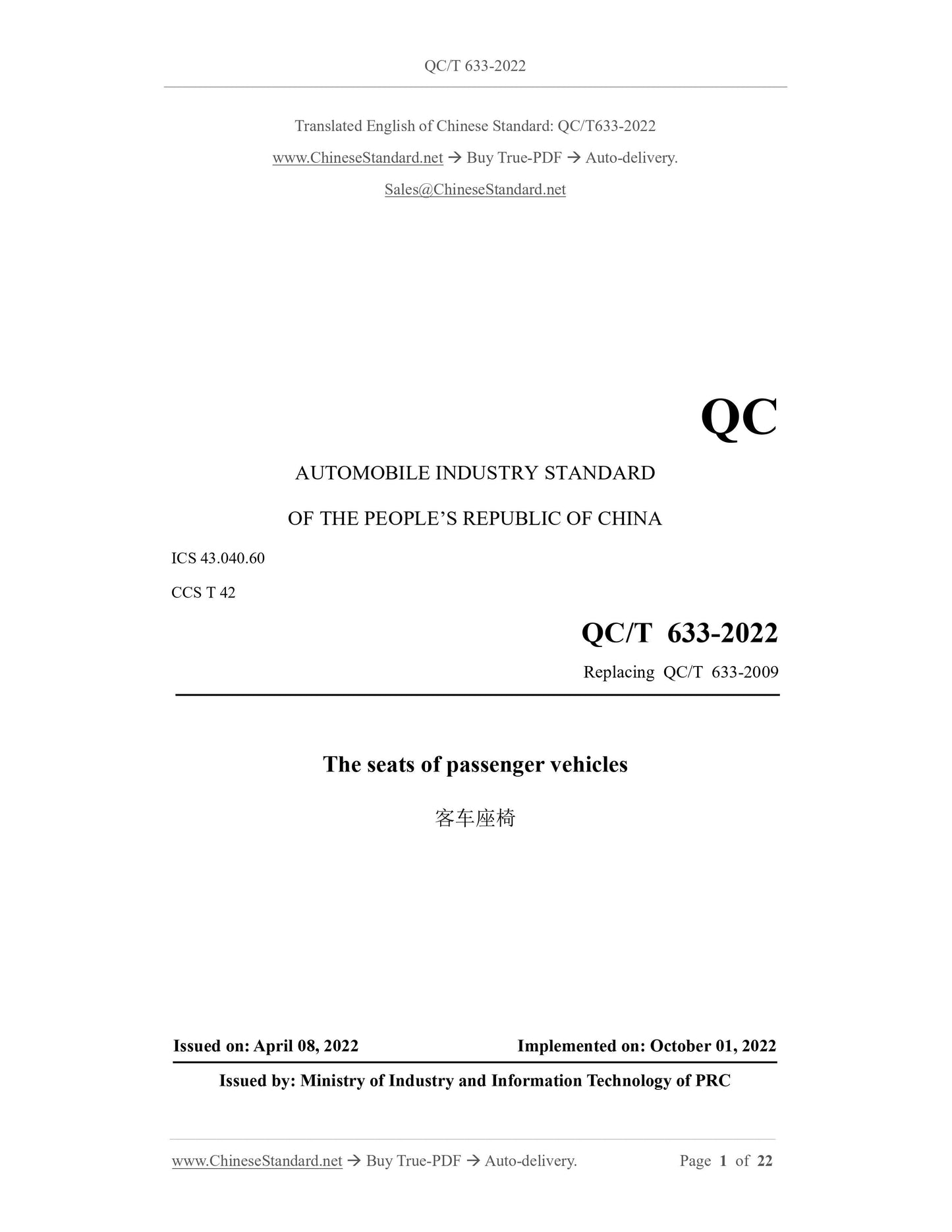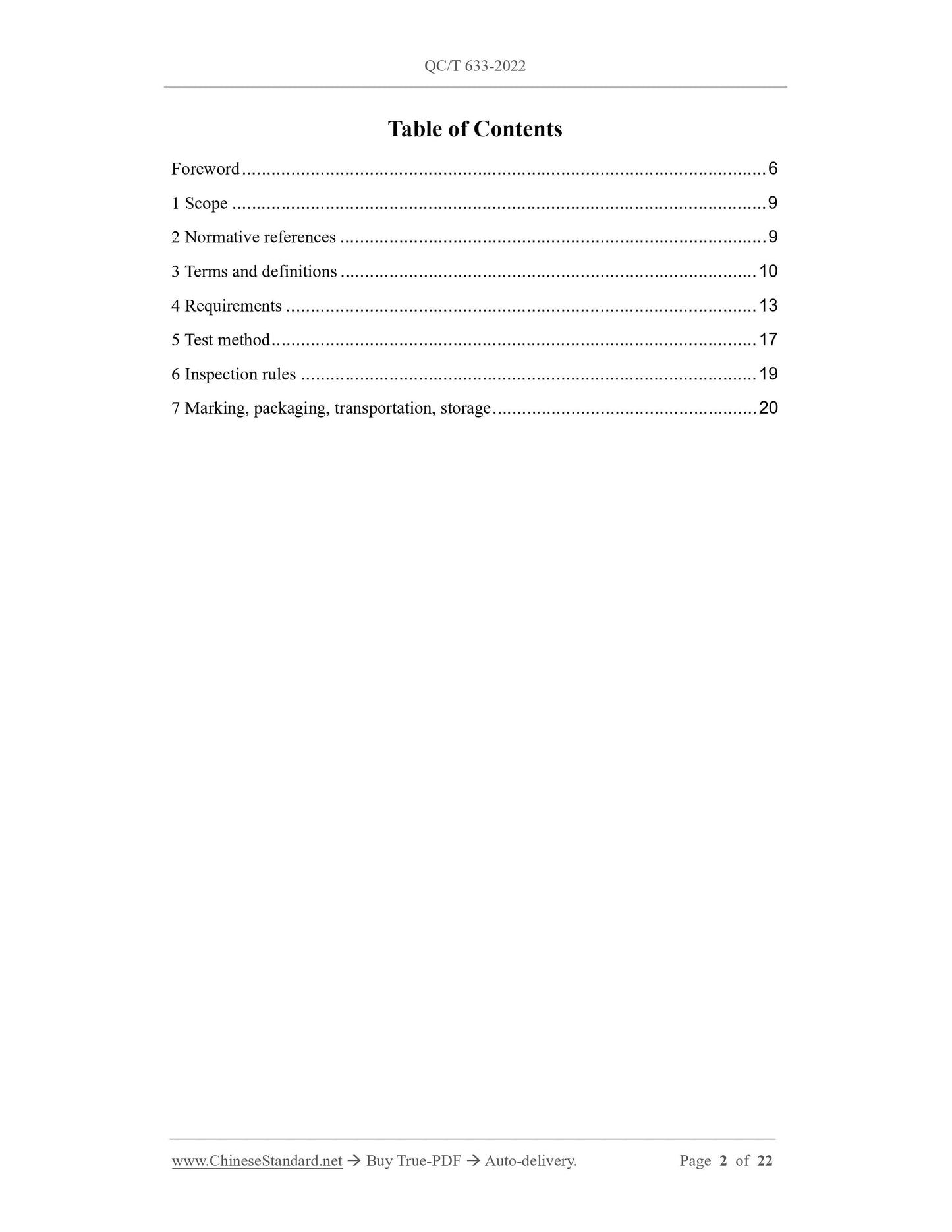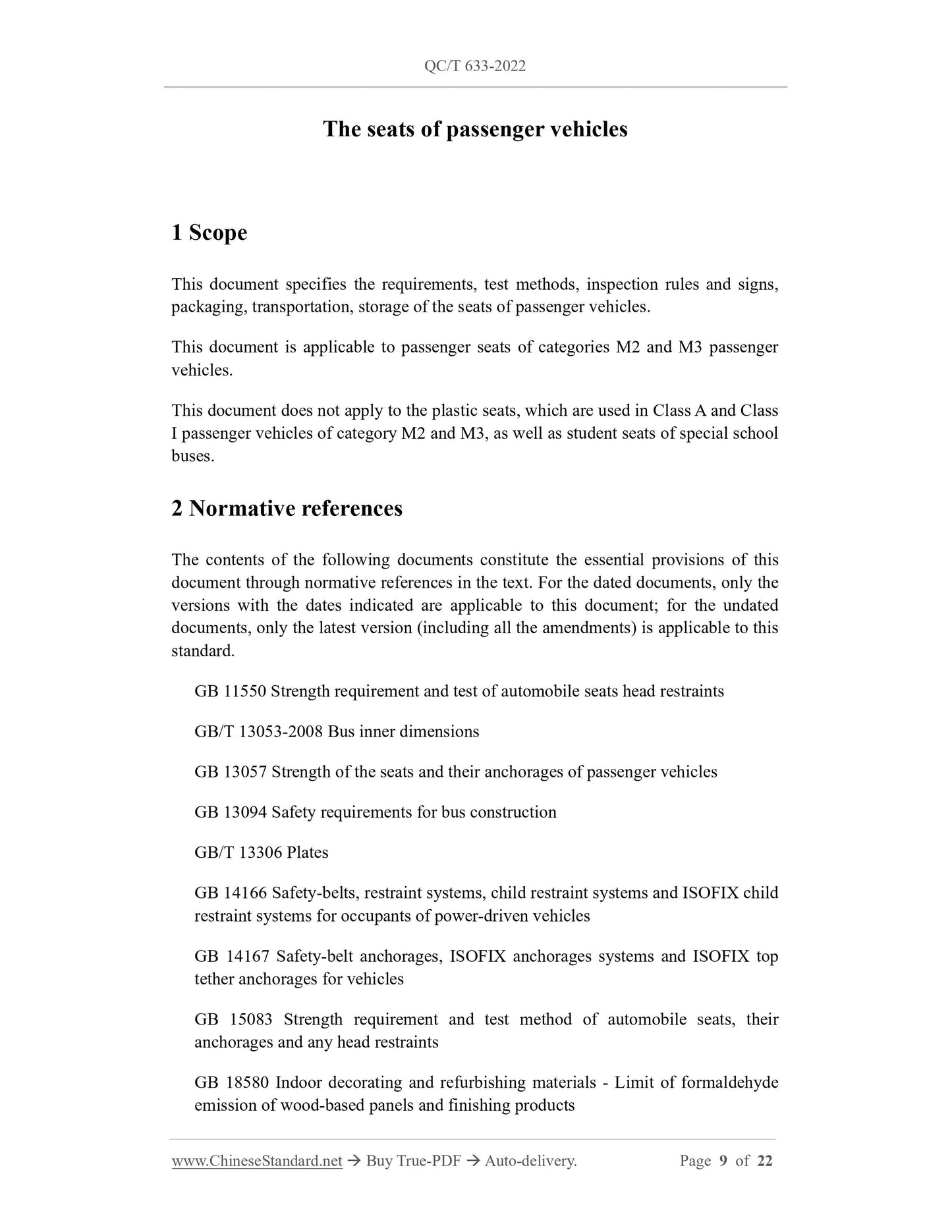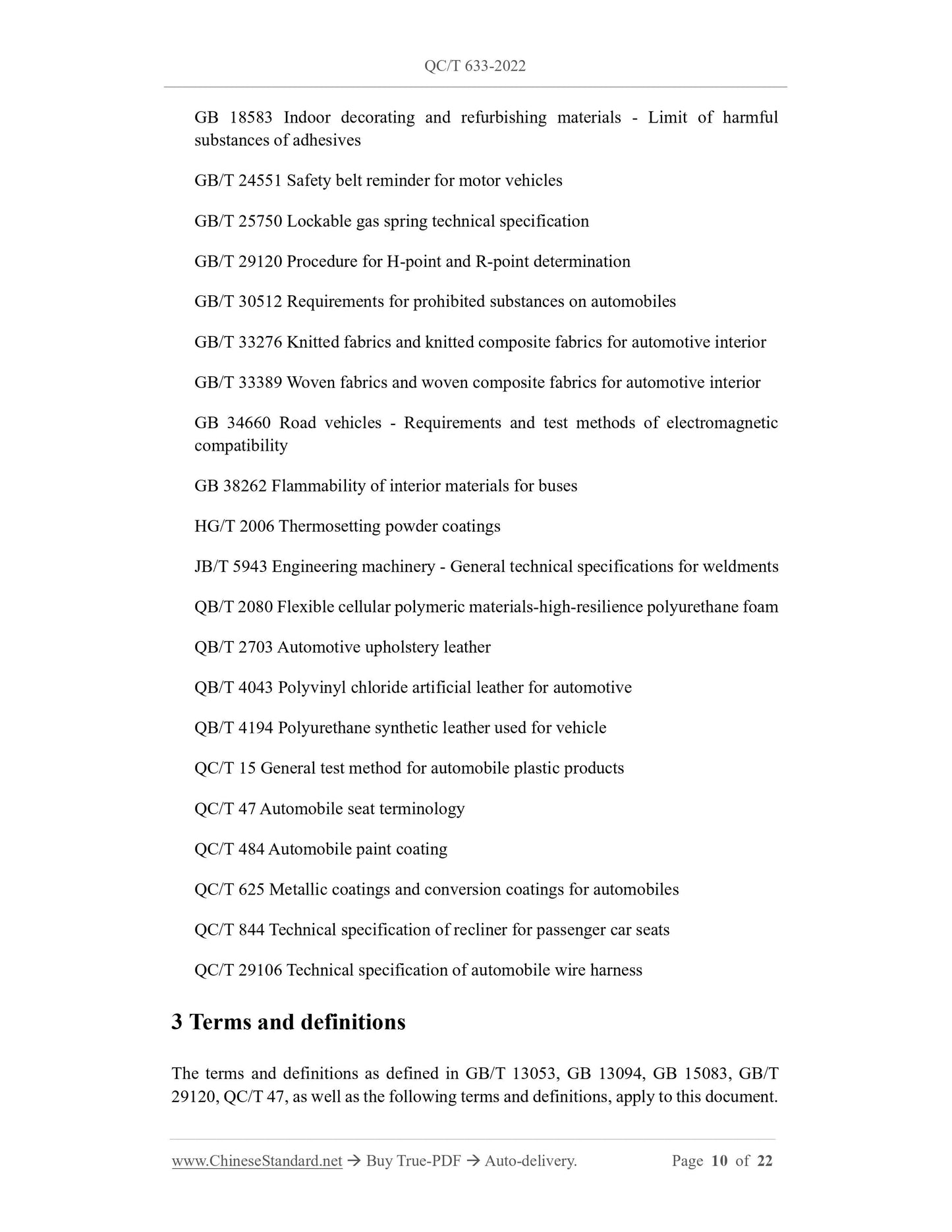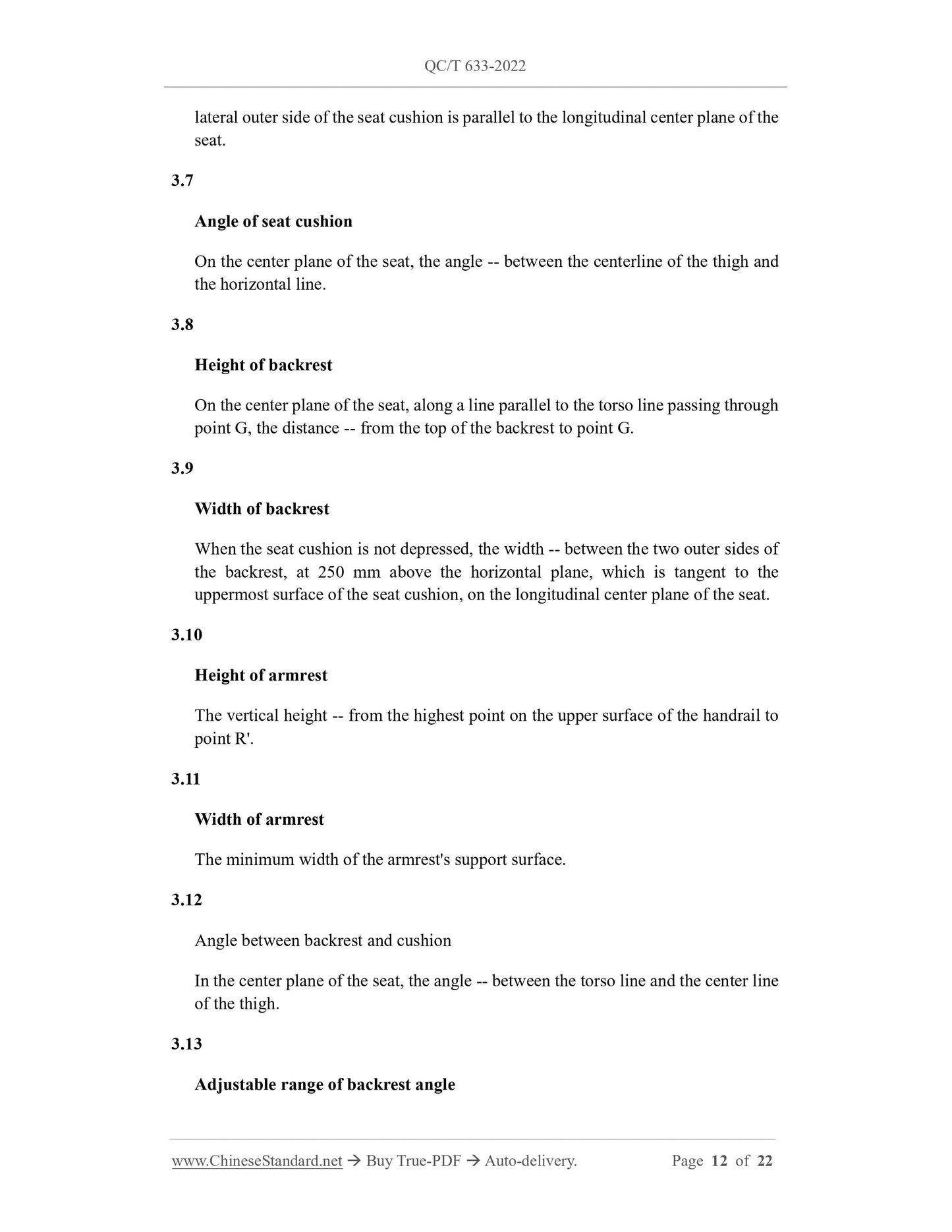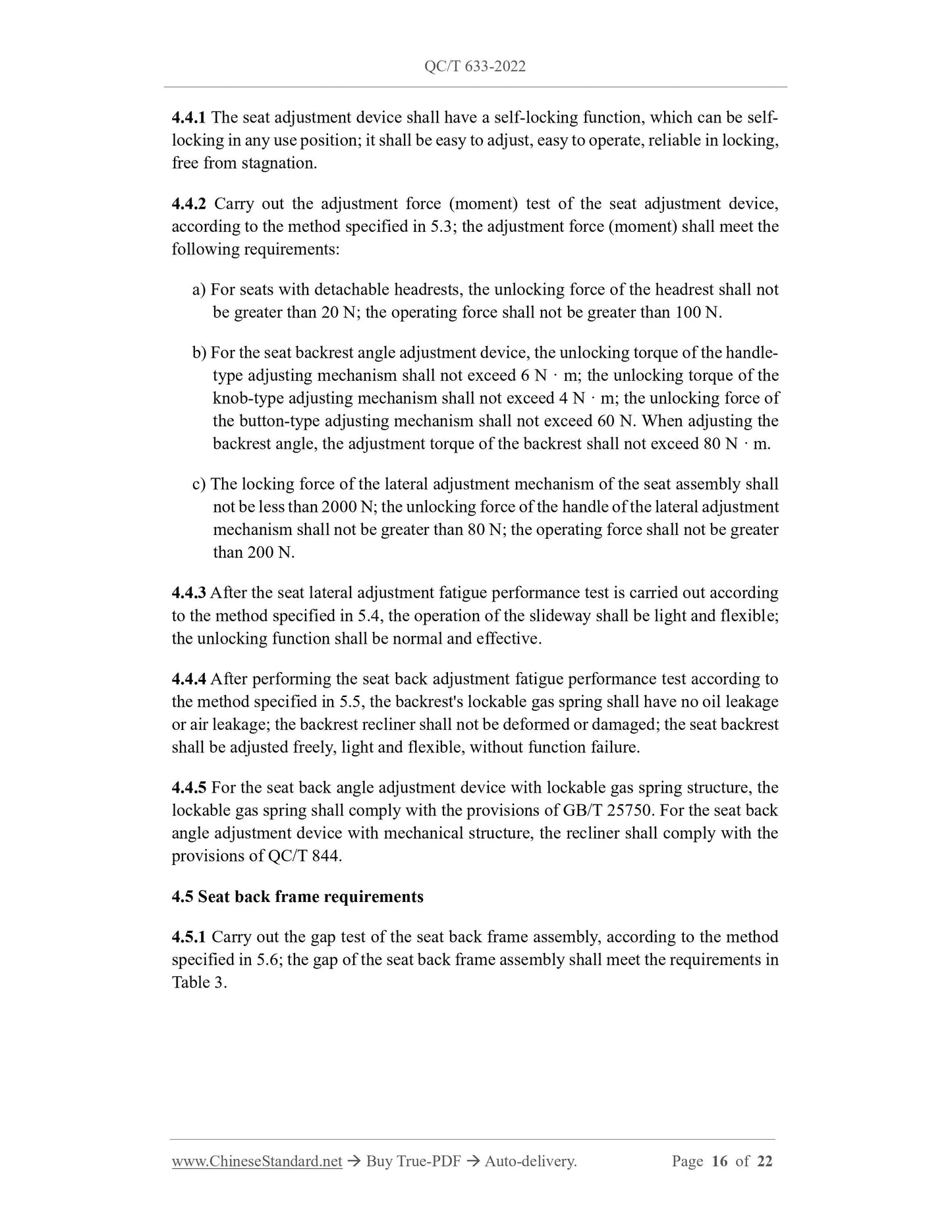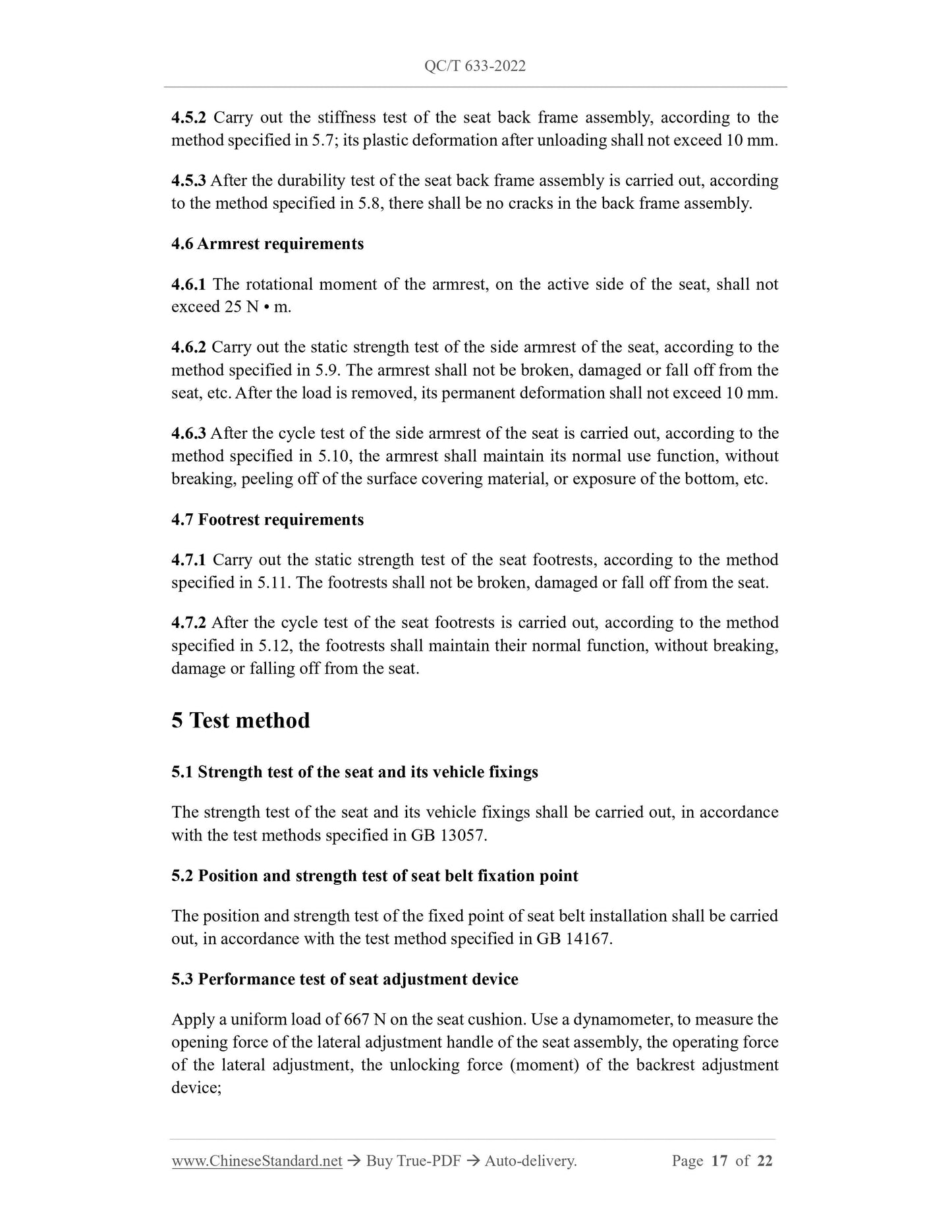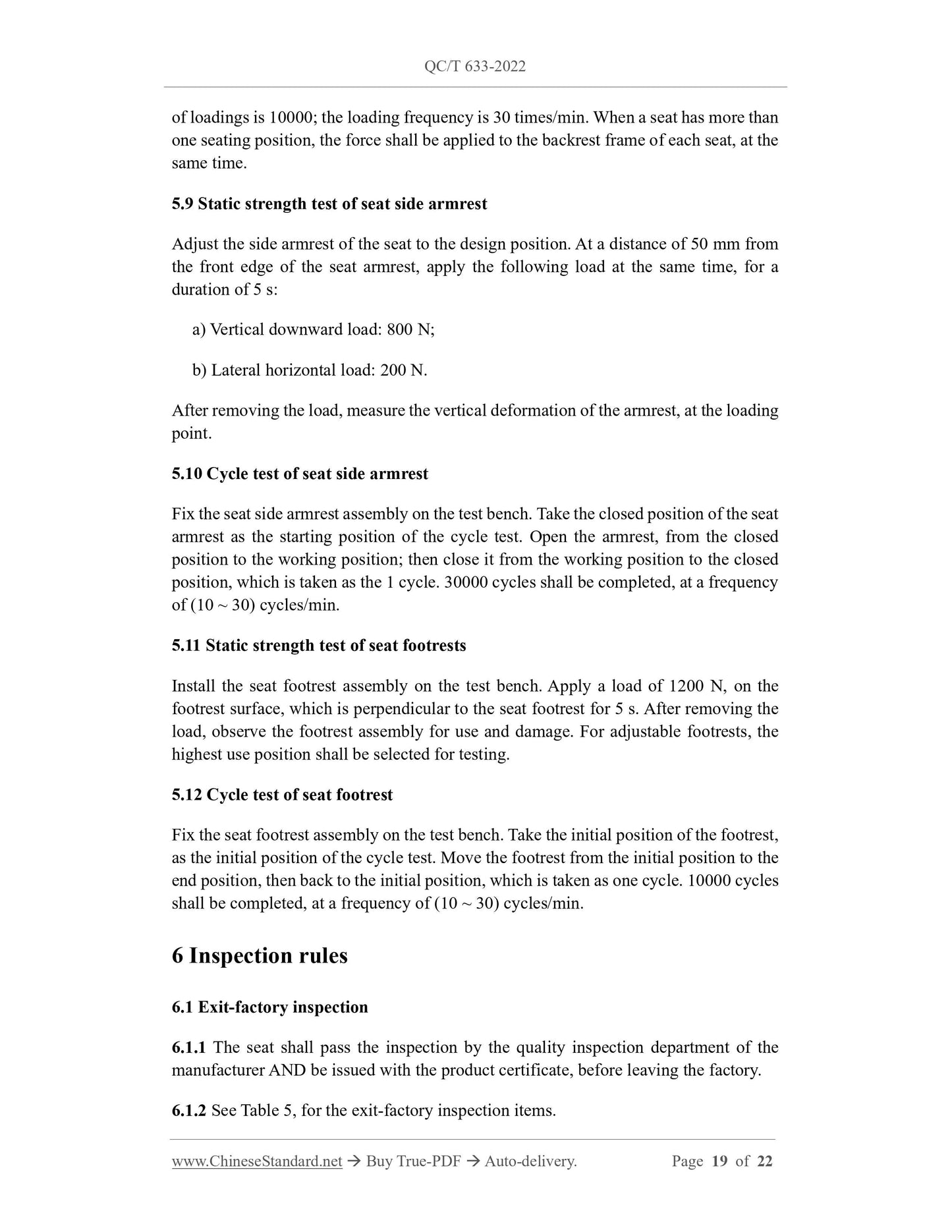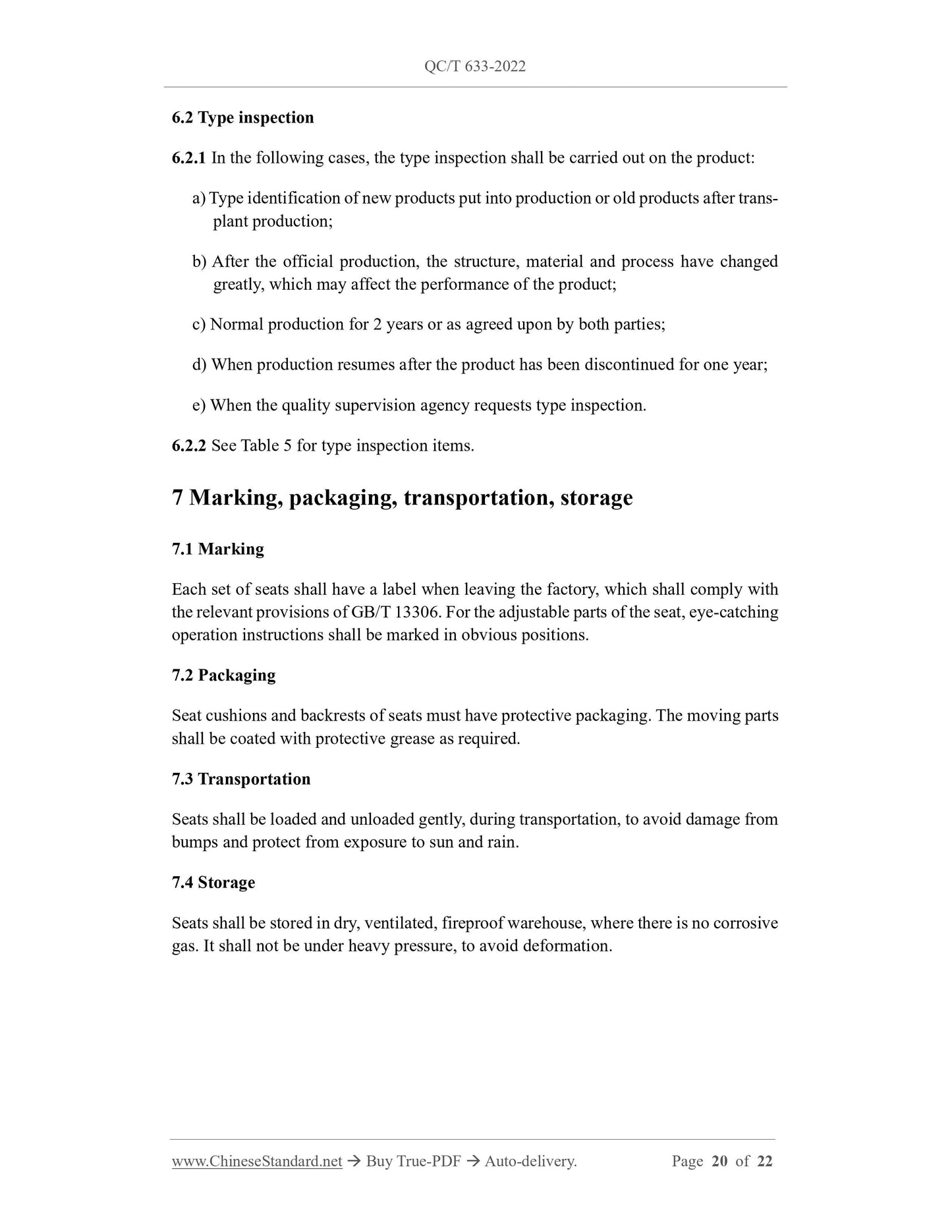1
/
of
9
PayPal, credit cards. Download editable-PDF & invoice in 1 second!
QC/T 633-2022 English PDF (QC/T633-2022)
QC/T 633-2022 English PDF (QC/T633-2022)
Regular price
$230.00 USD
Regular price
Sale price
$230.00 USD
Unit price
/
per
Shipping calculated at checkout.
Couldn't load pickup availability
Delivery: 3 seconds. Download true-PDF + Invoice.
Get QUOTATION in 1-minute: Click QC/T 633-2022
Historical versions: QC/T 633-2022
Preview True-PDF (Reload/Scroll if blank)
QC/T 633-2022: The seats of passenger vehicles
QC/T 633-2022
QC
AUTOMOBILE INDUSTRY STANDARD
OF THE PEOPLE’S REPUBLIC OF CHINA
ICS 43.040.60
CCS T 42
Replacing QC/T 633-2009
The seats of passenger vehicles
ISSUED ON: APRIL 08, 2022
IMPLEMENTED ON: OCTOBER 01, 2022
Issued by: Ministry of Industry and Information Technology of PRC
Table of Contents
Foreword ... 6
1 Scope ... 9
2 Normative references ... 9
3 Terms and definitions ... 10
4 Requirements ... 13
5 Test method ... 17
6 Inspection rules ... 19
7 Marking, packaging, transportation, storage ... 20
The seats of passenger vehicles
1 Scope
This document specifies the requirements, test methods, inspection rules and signs,
packaging, transportation, storage of the seats of passenger vehicles.
This document is applicable to passenger seats of categories M2 and M3 passenger
vehicles.
This document does not apply to the plastic seats, which are used in Class A and Class
I passenger vehicles of category M2 and M3, as well as student seats of special school
buses.
2 Normative references
The contents of the following documents constitute the essential provisions of this
document through normative references in the text. For the dated documents, only the
versions with the dates indicated are applicable to this document; for the undated
documents, only the latest version (including all the amendments) is applicable to this
standard.
GB 11550 Strength requirement and test of automobile seats head restraints
GB/T 13053-2008 Bus inner dimensions
GB 13057 Strength of the seats and their anchorages of passenger vehicles
GB 13094 Safety requirements for bus construction
GB/T 13306 Plates
GB 14166 Safety-belts, restraint systems, child restraint systems and ISOFIX child
restraint systems for occupants of power-driven vehicles
GB 14167 Safety-belt anchorages, ISOFIX anchorages systems and ISOFIX top
tether anchorages for vehicles
GB 15083 Strength requirement and test method of automobile seats, their
anchorages and any head restraints
GB 18580 Indoor decorating and refurbishing materials - Limit of formaldehyde
emission of wood-based panels and finishing products
GB 18583 Indoor decorating and refurbishing materials - Limit of harmful
substances of adhesives
GB/T 24551 Safety belt reminder for motor vehicles
GB/T 25750 Lockable gas spring technical specification
GB/T 29120 Procedure for H-point and R-point determination
GB/T 30512 Requirements for prohibited substances on automobiles
GB/T 33276 Knitted fabrics and knitted composite fabrics for automotive interior
GB/T 33389 Woven fabrics and woven composite fabrics for automotive interior
GB 34660 Road vehicles - Requirements and test methods of electromagnetic
compatibility
GB 38262 Flammability of interior materials for buses
HG/T 2006 Thermosetting powder coatings
JB/T 5943 Engineering machinery - General technical specifications for weldments
QB/T 2080 Flexible cellular polymeric materials-high-resilience polyurethane foam
QB/T 2703 Automotive upholstery leather
QB/T 4043 Polyvinyl chloride artificial leather for automotive
QB/T 4194 Polyurethane synthetic leather used for vehicle
QC/T 15 General test method for automobile plastic products
QC/T 47 Automobile seat terminology
QC/T 484 Automobile paint coating
QC/T 625 Metallic coatings and conversion coatings for automobiles
QC/T 844 Technical specification of recliner for passenger car seats
QC/T 29106 Technical specification of automobile wire harness
3 Terms and definitions
The terms and definitions as defined in GB/T 13053, GB 13094, GB 15083, GB/T
29120, QC/T 47, as well as the following terms and definitions, apply to this document.
lateral outer side of the seat cushion is parallel to the longitudinal center plane of the
seat.
3.7
Angle of seat cushion
On the center plane of the seat, the angle -- between the centerline of the thigh and
the horizontal line.
3.8
Height of backrest
On the center plane of the seat, along a line parallel to the torso line passing through
point G, the distance -- from the top of the backrest to point G.
3.9
Width of backrest
When the seat cushion is not depressed, the width -- between the two outer sides of
the backrest, at 250 mm above the horizontal plane, which is tangent to the
uppermost surface of the seat cushion, on the longitudinal center plane of the seat.
3.10
Height of armrest
The vertical height -- from the highest point on the upper surface of the handrail to
point R'.
3.11
Width of armrest
The minimum width of the armrest's support surface.
3.12
Angle between backrest and cushion
In the center plane of the seat, the angle -- between the torso line and the center line
of the thigh.
3.13
Adjustable range of backrest angle
4.4.1 The seat adjustment device shall have a self-locking function, which can be self-
locking in any use position; it shall be easy to adjust, easy to operate, reliable in locking,
free from stagnation.
4.4.2 Carry out the adjustment force (moment) test of the seat adjustment device,
according to the method specified in 5.3; the adjustment force (moment) shall meet the
following requirements:
a) For seats with detachable headrests, the unlocking force of the headrest shall not
be greater than 20 N; the operating force shall not be greater than 100 N.
b) For the seat backrest angle adjustment device, the unlocking torque of the handle-
type adjusting mechanism shall not exceed 6 N · m; the unlocking torque of the
knob-type adjusting mechanism shall not exceed 4 N · m; the unlocking force of
the button-type adjusting mechanism shall not exceed 60 N. When adjusting the
backrest angle, the adjustment torque of the backrest shall not exceed 80 N · m.
c) The locking force of the lateral adjustment mechanism of the seat assembly shall
not be less than 2000 N; the unlocking force of the handle of the lateral adjustment
mechanism shall not be greater than 80 N; the operating force shall not be greater
than 200 N.
4.4.3 After the seat lateral adjustment fatigue performance test is carried out according
to the method specified in 5.4, the operation of the slideway shall be light and flexible;
the unlocking function shall be normal and effective.
4.4.4 After performing the seat back adjustment fatigue performance test according to
the method specified in 5.5, the backrest's lockable gas spring shall have no oil leakage
or air leakage; the backrest recliner shall not be deformed or damaged; the seat backrest
shall be adjusted freely, light and flexible, without function failure.
4.4.5 For the seat back angle adjustment device with lockable gas spring structure, the
lockable gas spring shall comply with the provisions of GB/T 25750. For the seat back
angle adjustment device with mechanical structure, the recliner shall comply with the
provisions of QC/T 844.
4.5 Seat back frame requirements
4.5.1 Carry out the gap test of the seat back frame assembly, according to the method
specified in 5.6; the gap of the seat back frame assembly shall meet the requirements in
Table 3.
4.5.2 Carry out the stiffness test of the seat back frame assembly, according to the
method specified in 5.7; its plastic deformation after unloading shall not exceed 10 mm.
4.5.3 After the durability test of the seat back frame assembly is carried out, according
to the method specified in 5.8, there shall be no cracks in the back frame assembly.
4.6 Armrest...
Get QUOTATION in 1-minute: Click QC/T 633-2022
Historical versions: QC/T 633-2022
Preview True-PDF (Reload/Scroll if blank)
QC/T 633-2022: The seats of passenger vehicles
QC/T 633-2022
QC
AUTOMOBILE INDUSTRY STANDARD
OF THE PEOPLE’S REPUBLIC OF CHINA
ICS 43.040.60
CCS T 42
Replacing QC/T 633-2009
The seats of passenger vehicles
ISSUED ON: APRIL 08, 2022
IMPLEMENTED ON: OCTOBER 01, 2022
Issued by: Ministry of Industry and Information Technology of PRC
Table of Contents
Foreword ... 6
1 Scope ... 9
2 Normative references ... 9
3 Terms and definitions ... 10
4 Requirements ... 13
5 Test method ... 17
6 Inspection rules ... 19
7 Marking, packaging, transportation, storage ... 20
The seats of passenger vehicles
1 Scope
This document specifies the requirements, test methods, inspection rules and signs,
packaging, transportation, storage of the seats of passenger vehicles.
This document is applicable to passenger seats of categories M2 and M3 passenger
vehicles.
This document does not apply to the plastic seats, which are used in Class A and Class
I passenger vehicles of category M2 and M3, as well as student seats of special school
buses.
2 Normative references
The contents of the following documents constitute the essential provisions of this
document through normative references in the text. For the dated documents, only the
versions with the dates indicated are applicable to this document; for the undated
documents, only the latest version (including all the amendments) is applicable to this
standard.
GB 11550 Strength requirement and test of automobile seats head restraints
GB/T 13053-2008 Bus inner dimensions
GB 13057 Strength of the seats and their anchorages of passenger vehicles
GB 13094 Safety requirements for bus construction
GB/T 13306 Plates
GB 14166 Safety-belts, restraint systems, child restraint systems and ISOFIX child
restraint systems for occupants of power-driven vehicles
GB 14167 Safety-belt anchorages, ISOFIX anchorages systems and ISOFIX top
tether anchorages for vehicles
GB 15083 Strength requirement and test method of automobile seats, their
anchorages and any head restraints
GB 18580 Indoor decorating and refurbishing materials - Limit of formaldehyde
emission of wood-based panels and finishing products
GB 18583 Indoor decorating and refurbishing materials - Limit of harmful
substances of adhesives
GB/T 24551 Safety belt reminder for motor vehicles
GB/T 25750 Lockable gas spring technical specification
GB/T 29120 Procedure for H-point and R-point determination
GB/T 30512 Requirements for prohibited substances on automobiles
GB/T 33276 Knitted fabrics and knitted composite fabrics for automotive interior
GB/T 33389 Woven fabrics and woven composite fabrics for automotive interior
GB 34660 Road vehicles - Requirements and test methods of electromagnetic
compatibility
GB 38262 Flammability of interior materials for buses
HG/T 2006 Thermosetting powder coatings
JB/T 5943 Engineering machinery - General technical specifications for weldments
QB/T 2080 Flexible cellular polymeric materials-high-resilience polyurethane foam
QB/T 2703 Automotive upholstery leather
QB/T 4043 Polyvinyl chloride artificial leather for automotive
QB/T 4194 Polyurethane synthetic leather used for vehicle
QC/T 15 General test method for automobile plastic products
QC/T 47 Automobile seat terminology
QC/T 484 Automobile paint coating
QC/T 625 Metallic coatings and conversion coatings for automobiles
QC/T 844 Technical specification of recliner for passenger car seats
QC/T 29106 Technical specification of automobile wire harness
3 Terms and definitions
The terms and definitions as defined in GB/T 13053, GB 13094, GB 15083, GB/T
29120, QC/T 47, as well as the following terms and definitions, apply to this document.
lateral outer side of the seat cushion is parallel to the longitudinal center plane of the
seat.
3.7
Angle of seat cushion
On the center plane of the seat, the angle -- between the centerline of the thigh and
the horizontal line.
3.8
Height of backrest
On the center plane of the seat, along a line parallel to the torso line passing through
point G, the distance -- from the top of the backrest to point G.
3.9
Width of backrest
When the seat cushion is not depressed, the width -- between the two outer sides of
the backrest, at 250 mm above the horizontal plane, which is tangent to the
uppermost surface of the seat cushion, on the longitudinal center plane of the seat.
3.10
Height of armrest
The vertical height -- from the highest point on the upper surface of the handrail to
point R'.
3.11
Width of armrest
The minimum width of the armrest's support surface.
3.12
Angle between backrest and cushion
In the center plane of the seat, the angle -- between the torso line and the center line
of the thigh.
3.13
Adjustable range of backrest angle
4.4.1 The seat adjustment device shall have a self-locking function, which can be self-
locking in any use position; it shall be easy to adjust, easy to operate, reliable in locking,
free from stagnation.
4.4.2 Carry out the adjustment force (moment) test of the seat adjustment device,
according to the method specified in 5.3; the adjustment force (moment) shall meet the
following requirements:
a) For seats with detachable headrests, the unlocking force of the headrest shall not
be greater than 20 N; the operating force shall not be greater than 100 N.
b) For the seat backrest angle adjustment device, the unlocking torque of the handle-
type adjusting mechanism shall not exceed 6 N · m; the unlocking torque of the
knob-type adjusting mechanism shall not exceed 4 N · m; the unlocking force of
the button-type adjusting mechanism shall not exceed 60 N. When adjusting the
backrest angle, the adjustment torque of the backrest shall not exceed 80 N · m.
c) The locking force of the lateral adjustment mechanism of the seat assembly shall
not be less than 2000 N; the unlocking force of the handle of the lateral adjustment
mechanism shall not be greater than 80 N; the operating force shall not be greater
than 200 N.
4.4.3 After the seat lateral adjustment fatigue performance test is carried out according
to the method specified in 5.4, the operation of the slideway shall be light and flexible;
the unlocking function shall be normal and effective.
4.4.4 After performing the seat back adjustment fatigue performance test according to
the method specified in 5.5, the backrest's lockable gas spring shall have no oil leakage
or air leakage; the backrest recliner shall not be deformed or damaged; the seat backrest
shall be adjusted freely, light and flexible, without function failure.
4.4.5 For the seat back angle adjustment device with lockable gas spring structure, the
lockable gas spring shall comply with the provisions of GB/T 25750. For the seat back
angle adjustment device with mechanical structure, the recliner shall comply with the
provisions of QC/T 844.
4.5 Seat back frame requirements
4.5.1 Carry out the gap test of the seat back frame assembly, according to the method
specified in 5.6; the gap of the seat back frame assembly shall meet the requirements in
Table 3.
4.5.2 Carry out the stiffness test of the seat back frame assembly, according to the
method specified in 5.7; its plastic deformation after unloading shall not exceed 10 mm.
4.5.3 After the durability test of the seat back frame assembly is carried out, according
to the method specified in 5.8, there shall be no cracks in the back frame assembly.
4.6 Armrest...
Share
